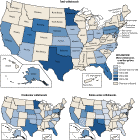
 |
Estimated Use of Water in the United States in 2000
Mining
Mining water use is water for the extraction of minerals that may be in the form of such solids as coal, iron, sand, and gravel; such liquids as crude petroleum; and such gases as natural gas. The category includes quarrying, milling (crushing, screening, washing, and flotation of mined materials), re-injecting extracted water for secondary oil recovery, and other operations associated with mining activities. All mining withdrawals were considered self-supplied. Water withdrawals were reported as freshwater or saline water. Dewatering was not reported as a mining withdrawal unless the water was used beneficially, such as dampening roads for dust control. For 2000, consumptive use was not reported for mining.
For 2000, the estimate of mining water use for the United States was based on estimates of total withdrawals for mining in 22 States, rather than on estimates from all States. These 22 States included the 12 States with the largest mining withdrawals during 1995, and 10 other States in which mining water-use data had been collected as part of a broader State water-use program for 2000. The 22 States that reported for 2000 accounted for 83 percent of the total mining water withdrawals during 1995. During 1995, withdrawals for mining accounted for a small percentage of the total water use, less than 1 percent of the total water withdrawals for all categories.
Mining withdrawals for 2000 are listed by State in table 11.
![]() For 2000, an estimated 3,490 Mgal/d, or 3,920 thousand acre-feet per year, were used. Mining withdrawals were nearly 1 percent of total withdrawals and less than 2 percent of total withdrawals for all categories excluding thermoelectric power. Ground water was the source for 58 percent of total withdrawals for mining. Most of the ground-water withdrawals for mining (62 percent) were saline, and most of the surface-water withdrawals (85 percent) were freshwater. Saline ground-water withdrawals and fresh surface-water withdrawals each represented 36 percent of the total withdrawals for mining.
For 2000, an estimated 3,490 Mgal/d, or 3,920 thousand acre-feet per year, were used. Mining withdrawals were nearly 1 percent of total withdrawals and less than 2 percent of total withdrawals for all categories excluding thermoelectric power. Ground water was the source for 58 percent of total withdrawals for mining. Most of the ground-water withdrawals for mining (62 percent) were saline, and most of the surface-water withdrawals (85 percent) were freshwater. Saline ground-water withdrawals and fresh surface-water withdrawals each represented 36 percent of the total withdrawals for mining.
Total withdrawals for mining for the 22 States that reported data during both 1995 and 2000 increased about 11 percent during this time period; ground-water withdrawals increased about 15 percent; and surface-water withdrawals increased 7 percent. Saline-water withdrawals increased 32 percent. Freshwater withdrawals remained about the same for 2000.
The geographic distribution of total, total freshwater, and total saline-water withdrawals is shown in figure 11.
 Texas, Minnesota, and Wyoming accounted for 46 percent of the total withdrawals for mining. Iron ore mining in Minnesota, sand and gravel operations in Nebraska, and sand operations in New Jersey accounted for the largest fresh surface-water withdrawals. Gas and oil operations in Alaska, California, Oklahoma, Texas, and Wyoming were responsible for the large saline ground-water withdrawals in those States. Mineral salt extraction from the Great Salt Lake in Utah accounted for the largest saline surface-water withdrawals in the United States.
Texas, Minnesota, and Wyoming accounted for 46 percent of the total withdrawals for mining. Iron ore mining in Minnesota, sand and gravel operations in Nebraska, and sand operations in New Jersey accounted for the largest fresh surface-water withdrawals. Gas and oil operations in Alaska, California, Oklahoma, Texas, and Wyoming were responsible for the large saline ground-water withdrawals in those States. Mineral salt extraction from the Great Salt Lake in Utah accounted for the largest saline surface-water withdrawals in the United States.
Sources of data for water use for mining included surveys of mining operations or State and Federal agencies that collect water withdrawal or discharge data for mining sites or mineral tonnages and associated coefficients. A determination of water withdrawals that are put to beneficial use in mining operations can be difficult to determine, especially when dewatering is necessary for extraction of the mineral. Water produced from dewatering varies in quality from fresh to saline, and generally is disposed of through surface discharge, ponding, or re-injection. Some of the less-mineralized water may be re-used for irrigation or livestock.
Water Use in the United States | USGS Water Resources of the United States
For more information: wu-info@usgs.gov